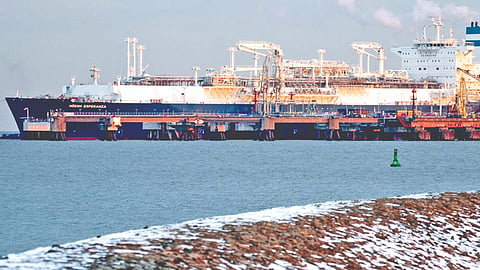

J MERK, M PENKE
On March 5, just over a week after Russia invaded Ukraine, European Commission President Ursula von der Leyen expressed concern that the Kremlin might turn off the bloc’s gas tap.
“The EU must get rid of its dependency on fossil fuels,” she wrote on Twitter. Von der Leyen then praised Spain, which she called “a frontrunner here, with its large renewables share and LNG capacities.”
It would not be the last time that von der Leyen appears to have placed liquefied natural gas within the category of renewable energies. The problem is that LNG is also a fossil fuel: It is pumped out of the ground — in some cases fracked — and in the end burned in ways that are destructive for the climate.
This conflation by von der Leyen, who spearheaded the European Green Deal, the EU’s road map to decarbonisation, could cost the bloc ecologically and financially.
At the Economist’s Sustainability Summit in March, UN Secretary-General Antonio Guterres called fossil fuels “a stupid investment, leading to billions in stranded assets.” Countries must “accelerate the phaseout of coal and all fossil fuels,” Guterres said.
“This is madness. Addiction to fossil fuels is mutually assured destruction.” And yet the EU is currently investing billions of euros into fossil fuel infrastructure that will either become obsolete or much more expensive to maintain if the bloc does not intend to further exacerbate the climate crisis.
The largest gas consumer in the EU is Germany, followed by Italy, the Netherlands, Slovakia and France, according to Eurostat. These countries are now trying to replace their gas imports from Russia with supplies from other sources.
“Since the beginning of the war, LNG imports to Europe have increased by 58%,” said Paula Di Mattia Peraire, a gas analyst with Independent Commodity Intelligence Services (ICIS). Because of this, Germany, Greece and Italy in particular — as well as Ireland, France, the Netherlands and Poland — are expanding their infrastructure to receive LNG.
“There is a lot of investments going on in Europe regarding LNG,” Peraire said. “If all these projects materialize — around 15 new projects till the end of 2024 — that will bring the regasification capacity up by 70 billion cubic meters per year.”
A particularly large amount of government money is flowing into coastal terminals where cooled LNG is offloaded and heated until it can be injected into pipeline networks. Currently, there are too few of these terminals — especially in the North Sea and Baltic Sea — to meet the European Union’s gas needs.
Furthermore, instead of flowing from east to west, LNG gas will have to flow from Spain, France and the Netherlands to Central and Eastern Europe. However, as gas pipelines are mostly one-way streets, a “reverse flow” is only possible to a limited extent.
The German capacities, which are geographically central within Europe and therefore key to the network, would have to be at least doubled for this to happen, according to the Fraunhofer Institute. Another heavy toll would come in commissioning a fleet to ship gas to Europe.
LNG tankers, easily recognizable by their spherical tanks, can hold up to 175,000 cubic meters of liquefied gas, the equivalent of 90 million cubic meters of less-dense pipeline gas.
So, to replace the annual 167 billion cubic meters of Russian gas, about 1,800 shiploads — or five per day — are needed for the European Union.
According to the Institute of Shipping Economics and Logistics, this would require 160 new tankers at a unit price of $220 million (212.5 million euros), for a total of $35.2 billion.
The European Union has announced its intent to become climate-neutral by 2050. Germany is aiming for 2045. If the EU burns more LNG, however, emissions will rise.
This article was provided by Deutsche Welle
Visit news.dtnext.in to explore our interactive epaper!
Download the DT Next app for more exciting features!
Click here for iOS
Click here for Android